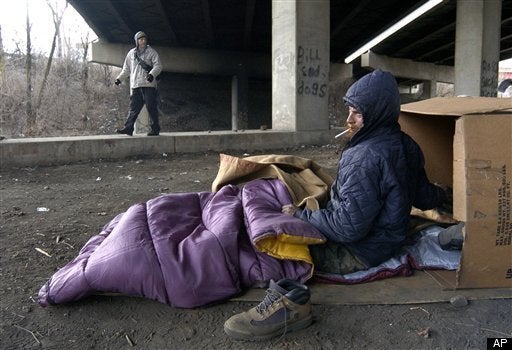
The U.S. Department of Housing and Urban Renewal (HUD) requires that every two years during the last seven days of January, Continuum of Care (CoC) systems (those agencies that HUD funds on a competitive basis) count the number of homeless people within their geographical areas.
HUD guidelines suggest that the best practice for counting homeless people is to count unsheltered homeless people on the same night as counting people staying in shelters or when the shelters are closed. Thus, while the counts of homeless people living in shelters take place during the day, the counts for unsheltered homeless people generally take place from midnight until 4:00 a.m., or from very early in the morning, often beginning before 4:00 a.m.
In 2007, the Los Angeles Homeless Services Authority (LAHSA), the lead agency for Los Angeles CoC, counted 68,608 homeless people residing within the Los Angeles CoC. Not included within the Los Angeles CoC count were the cities of Glendale, Long Beach and Pasadena, which counted a total of 5,094 homeless people in their cities. Thus, in 2007, the total count of homeless people in Los Angeles County was 73,702.
On October 28 of this year, LAHSA released its January 27-29, 2009 count of homeless people that found that 42,694 homeless people reside within the Los Angeles CoC. Again, not included within the Los Angeles CoC count were the cities of Glendale, Long Beach and Pasadena, which counted a total of 5,359 homeless people in their cities. Thus, in 2009, the homeless population in Los Angeles County was counted as 48,053.
While 48,053 homeless people is an extremely large number, representing misery for thousands of men, women and children, this number is surprising to some service providers because it represents an unexpected 38% decrease in the number of homeless people counted in 2007.
In its press release, "New Census Reveals Decline in Greater Los Angeles Homelessness," LAHSA attributes this 38% decrease in the number of homeless people counted in Los Angeles County in 2009 to "progress in the City's and County's efforts at reducing homelessness."
Of particular interest are the statistics that LAHSA quotes in its press release stating that:
[t]he decline in the numbers for Los Angeles appears consistent with similar national decreases [in the number of homeless people counted] seen in areas like:
New York:30% decrease
Indianapolis22% decrease
Riverside County22% decrease
I propose that counting all homeless people, whether sheltered or unsheltered, during the day would yield a more accurate number of the people who are homeless.
1. Finding unsheltered homeless people at night is problematic. In some cities, there is police activity to break up illegal public camping. However, on those nights at the end of January every two years, enumerators look forward to finding encampments so that they can find homeless people to count.
It would appear that the police and the enumerators are working at cross-purposes.
2. Would you like it if a team of enumerators came to your home in the middle of the night? Some homeless people know about the count process and may not want to be disturbed so perhaps they find more out-of-the-way places to stay on census nights.
3. Some unsheltered homeless people stay awake at night. Why? Because sleeping at night "outside" puts homeless people in a very vulnerable state. They often sit in well-lit areas or on buses, or they walk.
The unsheltered homeless people who do try to sleep at night often look for quiet, private places so they are protected from prying eyes, possible attacks and the elements.
4. I suggest that the enumerators bring non-perishable canned and packaged food with can openers to these hungry, poor people. This act of charity could make the counting experience something that homeless people might look forward to and for which they would make themselves more available.
5. Unsheltered homeless people can be more easily found during the day in public places, in food lines and at service providers' locations. Why not utilize the organizers and volunteers at these locations to help introduce the enumerators to their guests?
Finding unsheltered working homeless people can be accomplished by talking to the organizers, volunteers, service providers or friends who know these homeless people.
6. Concerned about double counting homeless people? Homeless people are knowable. Prior to the official counting dates, a team could just go out, meet homeless people and bring much-needed canned or packaged food. By knowing in advance many of the people they are counting, enumerators would know to avoid counting the same person twice.
Further, in the case of meeting a homeless person who enumerators have not previously met, the enumerators could simply ask the homeless person if he/she has been counted already. Once a trust or friendship has been established between any enumerator and any homeless person, this information will be more readily forth coming.
7. It would be helpful if each team of enumerators were accompanied by a trained mental health professional. Stress is a challenge for all of us and certainly homeless people experience a great deal of stress. Thus, by their mere calming presence, these mental health professionals would be providing a valuable service.
It is important for many reasons, including justifying the funding of homelessness services, that homeless people be counted. However, we must be as creative in our thinking about the ways to count them as homeless people are creative in the ways that they survive on the streets.
As fellow human beings, homeless people are entitled to our respect, need our help and deserve our compassion.
I look forward to your comments.
Thank you,
Christine